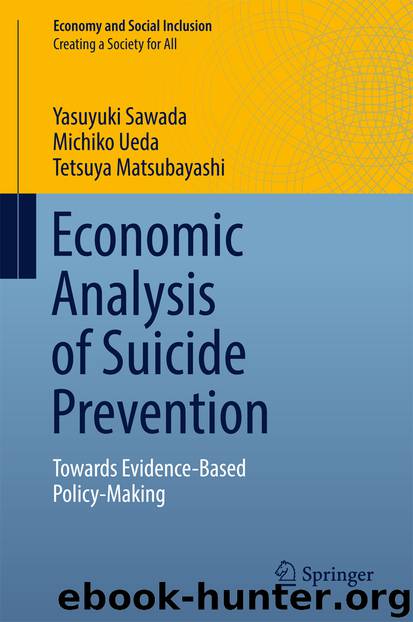Economic Analysis of Suicide Prevention by Yasuyuki Sawada Michiko Ueda & Tetsuya Matsubayashi

Author:Yasuyuki Sawada, Michiko Ueda & Tetsuya Matsubayashi
Language: eng
Format: epub
Publisher: Springer Singapore, Singapore
3 Relative Age and Suicide
A growing body of literature has examined the relationship between children’s relative age in a grade and their academic performance. Evidence collected in many parts of the world suggests that, compared to older students, students who are relatively younger at school entry tend to perform worse on achievement tests (Bedard and Dhuey 2006; Elder and Lubotsky 2009; Kawaguchi 2011) are more likely to be held back a grade in elementary school (Elder and Lubotsky 2009), and are less likely to attend college (Bedard and Dhuey 2006). Some studies reported that such “relative age effects” can have long-term consequences, affecting the level of income in adulthood (Fredriksson and Öckert 2014; Kawaguchi 2011) whereas others found no long-term wage effects (Dobkin and Ferreira 2010; Black et al. 2011).
This study extends the findings of these past studies and examines how relative age in a grade affects suicide mortality rates of adolescents and young adults between 15 and 25 years of age. We focus on mortality by suicide because it is likely to be associated with the mental health of adolescents and young adults, who can be affected by their experiences at school and academic achievement. It is known that academically struggling students are more likely than peers who succeed in academics to suffer from depression (Bandura et al. 1999; Fröjd et al. 2008; Quiroga et al. 2013), one of the major factors associated with suicide. Studies also document a direct link between low academic performance and suicidal behaviors (Martin et al. 2005; Madge et al. 2011; Taliaferro and Muehlenkamp 2014).
Not only can academic disadvantage be a risk factor for students while at school, it can also have long-term negative consequences, which could elevate a risk for suicide (Beautrais et al. 1996; Goodman 1999; Qin et al. 2000). Kawaguchi (2011) found that the difference in the years of education at ages 30-34 between those with a relative age disadvantage and those with an advantage was 0.13 and 0.08 for male and female workers, respectively. He also reported that men who were born between January and March earn 3.9% less than those with a relative age advantage (born in April-June), although he found no difference in wage for women (Kawaguchi 2011).
To our knowledge, almost no previous studies have examined the association between children’s relative ages within a cohort and their mortality rates. The only exception is a Canadian study in the late 1990s that examined suicides by individuals less than 20 years of age in Alberta (Thompson et al. 1999). They found that individuals who had completed suicide were more likely to have been relatively younger than their classmates when they were at school. However, they could not precisely assign individuals to more than 150 school districts in Alberta, where each local authority can set its school entry cutoff date, because they obtained only the addresses of individuals at the time of death. Moreover, the authors could not rule out the possibility that these individuals had received education outside Alberta, making their calculation of relative age even more imprecise.
Download
This site does not store any files on its server. We only index and link to content provided by other sites. Please contact the content providers to delete copyright contents if any and email us, we'll remove relevant links or contents immediately.
International Integration of the Brazilian Economy by Elias C. Grivoyannis(86549)
The Radium Girls by Kate Moore(11870)
Turbulence by E. J. Noyes(7898)
Nudge - Improving Decisions about Health, Wealth, and Happiness by Thaler Sunstein(7465)
The Black Swan by Nassim Nicholas Taleb(6950)
Rich Dad Poor Dad by Robert T. Kiyosaki(6321)
Pioneering Portfolio Management by David F. Swensen(6172)
Man-made Catastrophes and Risk Information Concealment by Dmitry Chernov & Didier Sornette(5880)
Zero to One by Peter Thiel(5640)
Secrecy World by Jake Bernstein(4596)
Millionaire: The Philanderer, Gambler, and Duelist Who Invented Modern Finance by Janet Gleeson(4303)
Skin in the Game by Nassim Nicholas Taleb(4125)
The Age of Surveillance Capitalism by Shoshana Zuboff(4121)
The Money Culture by Michael Lewis(4029)
Bullshit Jobs by David Graeber(3997)
Skin in the Game: Hidden Asymmetries in Daily Life by Nassim Nicholas Taleb(3870)
The Dhandho Investor by Mohnish Pabrai(3639)
The Wisdom of Finance by Mihir Desai(3609)
Blockchain Basics by Daniel Drescher(3432)
